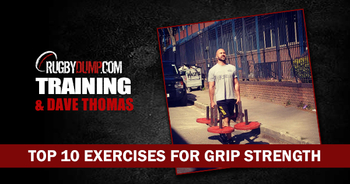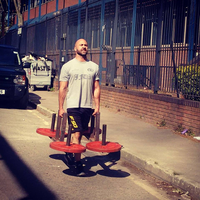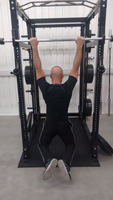
“Nobody picks on a strong man.”
Charles Atlas
Why is grip training for rugby so important?
Have you ever played rugby, or trained, with a farmer, fisherman or someone else with a ‘real job’? Have you secretly admired their effortless ‘Dad strength’ as they tear up phone books, bend horseshoes and members of the opposite sex swoon? One of the main reasons certain players, who may not even appear that strong in classic gym exercises, can dominate the rugby field is due to grip strength.
Grip strength is one of the most overlooked elements of strength and conditioning for rugby. Considering the majority of rugby activities require significant hand and forearm strength this seems an oversight. It’s an essential component for tackling opponents, lifting jumpers, jackling for the ball, scrummaging, rucking, mauling, passing and catching. It’s also pretty useful for carrying your round back from the bar.
If your grip fails, all your technique goes out of the window. You’re only ever as strong as your weakest link. People are amazed how strong many of the females who attend my City Strongman classes are but then I point out they’re using 90kg farmers walks and fat strongman logs multiple times a week.
How to test your grip strength
Rather than rely on abstract match based feedback such as ‘feeling stronger’ it’s good to test your current strength levels in a standardised, scientific way and grip is no exception. There are several ways to assess hand and forearm strength, which can be used regularly to gauge the development of strength and give you something to aim for.
Test 1
The easiest way to perform a grip strength test is to use a specialist piece of equipment called a Dynamometer.
You simply grip this as hard as you can and then record the maximum reading (kg) from three attempts. You can compare your results to the data below as a general guideline.
| Classification | Male, L | Male, R | Female, L | Female, R |
| Excellent | >68 | >70 | >37 | >41 |
| Good | 56-67 | 62-69 | 34-36 | 38-40 |
| Average | 43-55 | 48-61 | 22-33 | 25-37 |
| Below Average | 39-43 | 41-47 | 18-21 | 22-24 |
| Poor | <39 | <41 | <18 | <22 |
Test 2
A far less accurate way of measuring grip but a useful way to measure progress is to use a set of bathroom scales. This won’t reflect very well to the previous table but it’s a simple and a effective general test to compare imbalances in grip between hands and to chart progress. Just squeeze the scale in your hand as hard as you possibly can
Test 3
If you want to stroke/destroy your ego whilst testing your grip you can turn your hand (pardon the pun) to “captains of crush”. There’s a competitive element to these as well as an entertaining (albeit expensive) grip test however you can’t help but have a go when someone produces one.
How to improve your grip strength
So you’ve tested it and your grip is worse than Bambi on ice. Below are 10 exercises guaranteed to increase the strength on your elbow and hand strength. But first a note of caution!
Whilst grip is important it’s not more important than general strength. Missing a tackle is rarely down to a lack of grip strength. It’s more likely to be a lack of strength in the legs, torso or shoulders. First of all get ‘generally strong’ with traditional exercises. The best place to turn for those is the excellent strength training programmes written by my colleague Kevin Shattock: https://www.rugbydump.com/products
I do not prioritise grip training over traditional rugby S&C. I focus on getting people strong and fit and then adding in grip training here and there as a variation or during conditioning workouts. Don’t detract from your primary goal of the workout. For example, if you need to increase your deadlift using a fat bar will simply reduce the amount you can lift so is counter-productive.
The exercises below have been chosen as they target the different aspects of grip strength (crush, support, pinch, extension etc) and they don’t required a huge amount of equipment:
Fat Gripz
Simply put these replicate the effect of fat bar work without having to own, borrow or find a gym with 20 different custom made fat bars. You can strap them on barbells, dumbbells, chin up bars cable attachments etc. Thicker handles stimulate much more muscle activation in the hands forearms and in the upper arms: http://www.fatgripz.co.uk
Farmers’ Walks/Suitcase carry
The farmers walk trains joint stability and strength throghout the legs, torso, back and shoulders as well as being a significantly grip challenger. If you don’t have access to plate loaded competition style carries use the heaviest dumbbells you can hold or a trap bar
Loaded Carries

One of my favourite coaches Dan John says that: “The loaded carry does more to expand athletic qualities than any other single thing I’ve attempted in my career as a coach and an athlete.”
This is a broad term for carrying kegs, sandbags, atlas stones, power bags, dumbbells, plates, rugby tackle bags, any odd shaped object with bulk and unpredictability. These force you to constantly react and make adjustments in your grip and movements. They are therefore a great way to translate all that hard work you’ve put into the gym onto the pitch. Use them in a relay setting with team mates.
Pinch grip
Simply pinch a weight plate between the thumb and fingers and hold for time. Select a weight which you can hold by your side in one or in front in two hands for up to 15 seconds to failure. If you can hold it easily for 15 seconds, go to a heavier weight. Do 3-4 sets.
Tyre Flips
Anyone who has ever done one knows that initiating a tyre flip requires enormous demands on your grip. Tyre Flips also challenge the biceps as a stabliser muscle rather than a prime mover. If you grip stuggles compared to the weight of the tyre use a plank of wood underneath to allow purchase until you’re developed enough strength to lift from the floor. For more details see our MST manual for rugby in RSA (link)
Rice Bucket
This old school exercise is a great way to improve crushing strength and develop finger strength. There are lots of ways to perform exercises while submerged in a bag of rice or sand but first try opening and closing the fingers fully submerged and squeezing the rice and then moving your wrists up and down and side to side
Hammer time
You can use a sledgehammer, or a weight on the end of a stick or bat to develop rotational grip strength and isometric and dynamic strength of the wrists. Firstly bend your elbow and rotate the stick/hammer in a semicircle close to or hitting failure. Then you can do the same with wrist extension and flexion. Simply bend the wrist from your side to the hip in a curling motion (not dissimilar to a bicep curl but focus on the wrist movement. You can then do the same with an extension movement (not dissimilar to a tricep extension). Experiment but remember the further the hand is away from the weight, the harder the exercise becomes. Sledgehammer tyre training has been used by athletes for decades as a highly effective way to build endurance alongside speed, accuracy and grip strength. Using a sledgehammer to hit a tyre (or anything for that matter but I don’t advocate unnecessary DIY) requires excellent grip & forearm strength under control.
Towel chins ups/rows
If you want to experience serious finger and arm pain banish your usual rowing exercises and throw a tower over whatever your pulling. We’ll use chins as an example but you can do this with exercises like dumbbell rows, machine rows or horizontal bodyweight rows too. Don’t tie any knots in the towel and thow it over a chin up bar. Now simply perform as man chins as you can for 3-4 sets. They giggle like a schoolgirl as your struggle to wash you hair afterwards
Towel wringing
I like this grip exercise as you don’t even need to be in the gym. Find a suitable (smallish) towel, cloth or rag. You can do this dry (often a prescribed rehab exercise for elbow injuries) but if you want to be hardcore, fill a bucket with water (it’s useful to mark the water level at the start for a target). Holding the wet towel squeeze the water out of the towel out by twisting and squeezing as hard as you can. When you’re done all the way through the towel, the water should be at the original level.
Bar Hangs

If you ever played ‘shark infested waters’ in the playground as kid you’ll know any type of passive or dynamic hanging for time, be it from a bar, plank, beam, rings or tree (but not a post match drinking session) will improve your grip. However for a real challenge put an Olympic bar on top of a squat or power rack and use this to hang from. As your grip fails the bar begins to roll out of your hands creating all kinds of instability. You can also use a towel, as with the chin ups earlier, as an alternative and a means to build up to chins if they’re currently too hard. Hanging from a regular chin up bar isn’t the same as it’s stable and doesn’t roll but if your gym doesn’t have a squat rack it’s an ‘ok’ alternative.
(Although if your gym doesn’t have a squat rack perform a dirty protest on their bosu balls and find a new gym).
If you have any questions about this article please feel free to drop me a line.
Meet Coach DaveDave Thomas is the founder of the The Foundry, one of the most renowned health and fitness companies in London delivering personal training, education, and events and Co-Owner of City Strongman which uses equipment and exercises from the world of strongman training and athletic performance to offer affordable, results based group training. As one of London’s leading personal trainers, Dave has also accumulated over 10,000 personal training hours with a diverse range of clients including city professionals, celebrities and professional athletes and as such he is in demand as a fitness writer and speaker. Dave is a founding trustee and fitness coach for The School of Hard Knocks the social inclusion charity which helps unemployed people improve their confidence and find work. And now, we are pleased to announce that Dave is also now one of our Rugby Strength Academy Performance Coaches and we’re thrilled to have him on board. |  |
Sign In